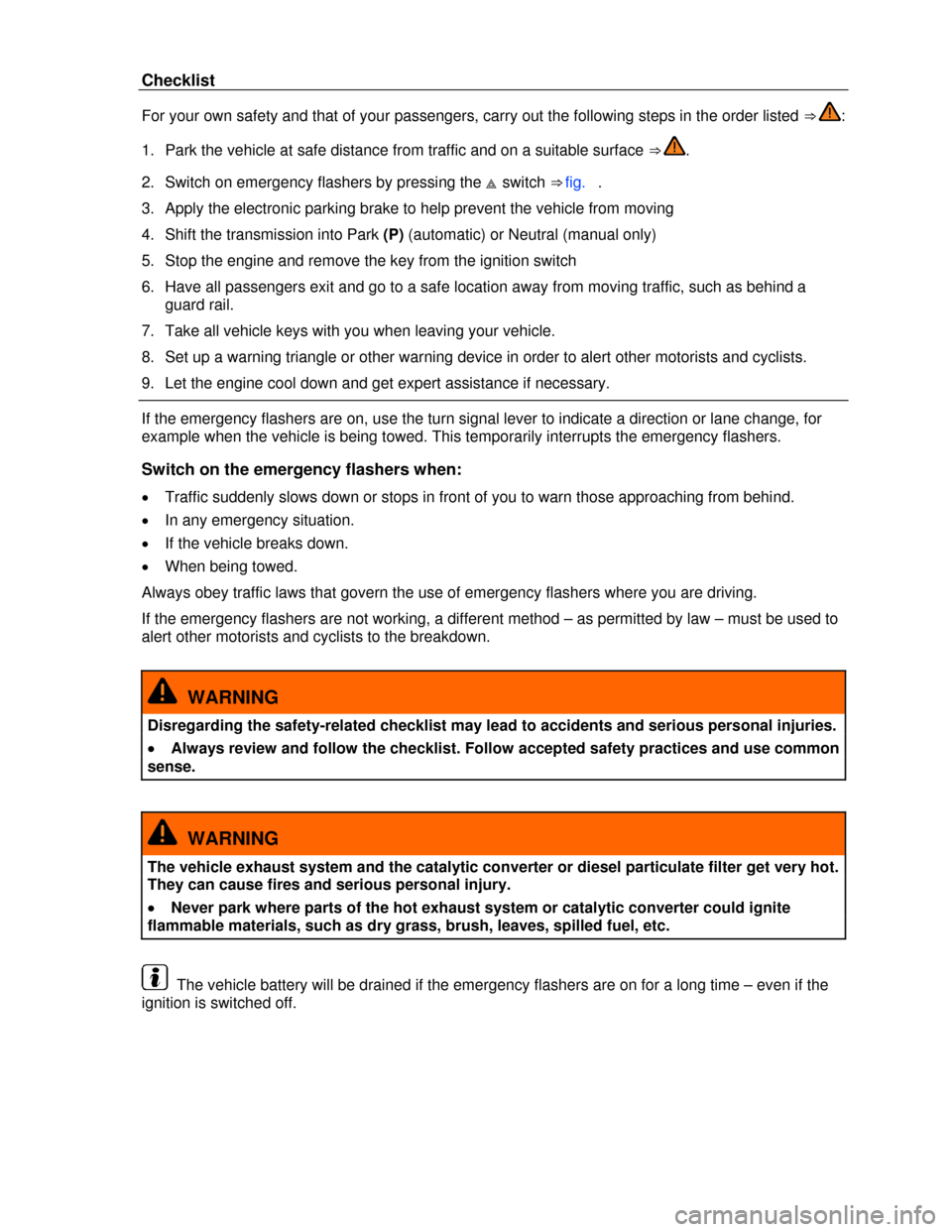Page 70 of 356

fig. 41 Press the switch in the direction of the arrow:
(2) and (3) Raise or lower the seat cushion.
(2) or (3) Adjust seat cushion angle.
(B) Forward or
backward. Adjust backrest angle.
Press fig. 42 switch for each area:
(1) or (2) Adjust lumbar support.
(3) or (4) Adjust lumbar support height.
WARNING
Improper use of electrical seat controls can cause serious personal injuries.
�x The front seats in your vehicle can be electrically adjusted even when the vehicle key has
been removed from the ignition or, on a vehicle with Keyless Access, even if there is no key
in the vehicle.
�x Never leave children and persons who need help in the vehicle alone because the unsu-
pervised use of the electric seat adjustments can result in serious personal injury.
�x Always make sure that no one is in the way while the front seats are being adjusted, or
while calling up the stored memory settings for the front seats. In an emergency, stop auto-
matic seat adjustment by pressing a seat adjustment switch.
NOTICE
To help prevent damage to electrical parts in the seat, do not kneel on the front seats or apply
concentrated pressure to a small area of the seat or backrest.
If the vehicle battery is too weak, the electrical seat adjustment controls may not work.
Starting the engine stops seat adjustment.
When entering and exiting the vehicle, be careful not to come into contact with any switches that
could change the seat adjustment.
Page 322 of 356

Frequently asked questions
If you suspect a malfunction or vehicle damage, read and follow the following advice before contacting
an authorized Volkswagen dealer or an authorized Volkswagen Service Facility. You may also find
helpful information under “Characteristics” and “Checklist” in the index.
Description Possible causes among
others Possible remedy
Engine does not start.
Vehicle battery dead. – Perform jump start
– Charge vehicle battery
The wrong remote control
vehicle key is used.
Use a valid remote control vehicle key
Fuel level too low. Refuel
Vehicle cannot be locked
or unlocked using remote
control vehicle key.
– Battery in remote control
vehicle key dead.
– Too far away from vehicle.
– Buttons pressed outside
operating range.
– Replace battery in the remote control
key
– Move closer to vehicle.
– Synchronize remote control vehicle
key
– Lock or unlock vehicle manually
Unusual noises.
Cold engine, braking support
systems, electronic parking
brake.
Check the “Noises” entry in the
keyword index.
Driver seat and outside
mirrors when vehicle is
unlocked.
Convenience settings are
stored. Correct convenience settings
Memory-seat settings are
stored.
– Reassign seat setting
– Clear memory-seat memory
Front seats cannot be
adjusted with power
controls.
Vehicle battery dead. Charge vehicle battery
Fuse blown. Check fuse and replace if necessary
Features do not work as
described in this manual.
Settings were adjusted in the
Volkswagen Information
System.
Check and reset to factory settings if
necessary
Headlights do not light up
the road as they should.
– Headlights incorrectly
adjusted.
– Light bulbs burned out.
– Low beams not switched on.
Have the headlight range adjusted by
an authorized Volkswagen dealer or an
authorized Volkswagen Service
Facility. Adjust headlight range .
– Change light bulbs
– Switch on low beams
Electrical consumers do
not work.
Vehicle battery charge too low. Charge vehicle battery
Remaining fuel level too low. Refuel .
Fuse blown. Check fuse and replace if necessary
Fuel consumption higher
than indicated.
– Short hauls.
– “Jumpy gas pedal”.
– Avoid short distance driving.
– Drive defensively.
– Accelerate smoothly.
Electrical loads switched on. Switch off unnecessary loads.
Engine control malfunctioning. Have the malfunction corrected
Page 325 of 356

Checklist
For your own safety and that of your passengers, carry out the following steps in the order listed ⇒ :
1. Park the vehicle at safe distance from traffic and on a suitable surface ⇒ .
2. Switch on emergency flashers by pressing the �� switch ⇒ fig. .
3. Apply the electronic parking brake to help prevent the vehicle from moving
4. Shift the transmission into Park (P) (automatic) or Neutral (manual only)
5. Stop the engine and remove the key from the ignition switch
6. Have all passengers exit and go to a safe location away from moving traffic, such as behind a
guard rail.
7. Take all vehicle keys with you when leaving your vehicle.
8. Set up a warning triangle or other warning device in order to alert other motorists and cyclists.
9. Let the engine cool down and get expert assistance if necessary.
If the emergency flashers are on, use the turn signal lever to indicate a direction or lane change, for
example when the vehicle is being towed. This temporarily interrupts the emergency flashers.
Switch on the emergency flashers when:
�x Traffic suddenly slows down or stops in front of you to warn those approaching from behind.
�x In any emergency situation.
�x If the vehicle breaks down.
�x When being towed.
Always obey traffic laws that govern the use of emergency flashers where you are driving.
If the emergency flashers are not working, a different method – as permitted by law – must be used to
alert other motorists and cyclists to the breakdown.
WARNING
Disregarding the safety-related checklist may lead to accidents and serious personal injuries.
�x Always review and follow the checklist. Follow accepted safety practices and use common
sense.
WARNING
The vehicle exhaust system and the catalytic converter or diesel particulate filter get very hot.
They can cause fires and serious personal injury.
�x Never park where parts of the hot exhaust system or catalytic converter could ignite
flammable materials, such as dry grass, brush, leaves, spilled fuel, etc.
The vehicle battery will be drained if the emergency flashers are on for a long time – even if the
ignition is switched off.